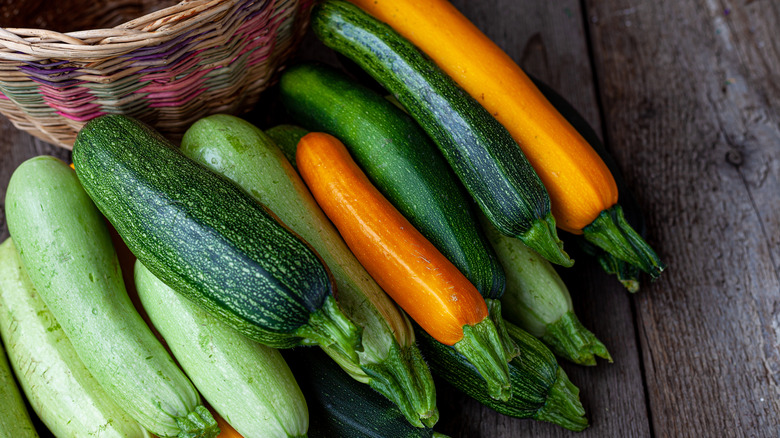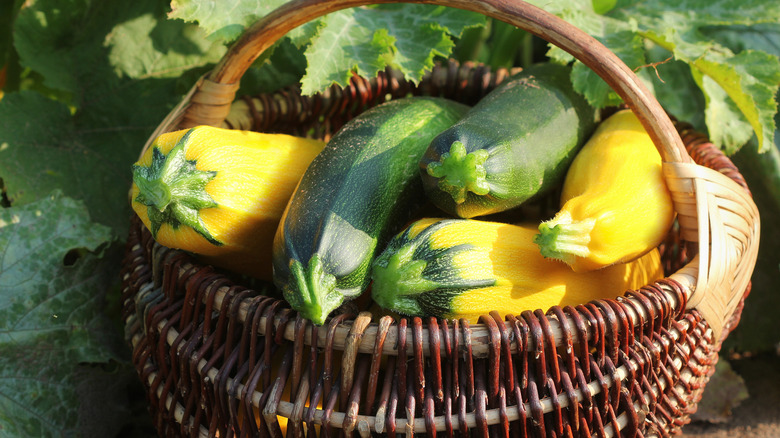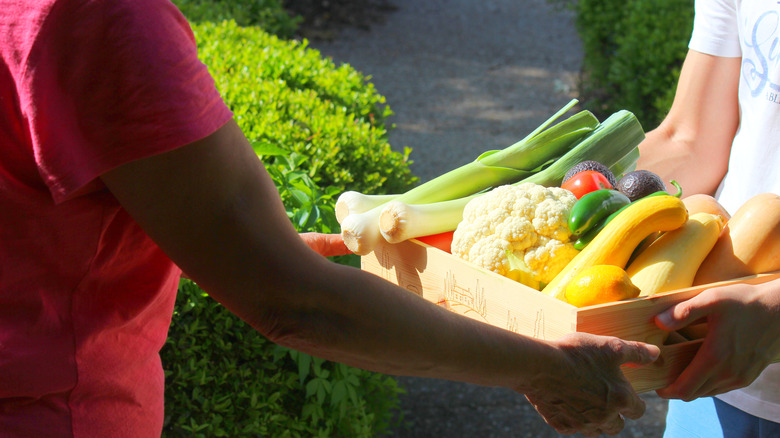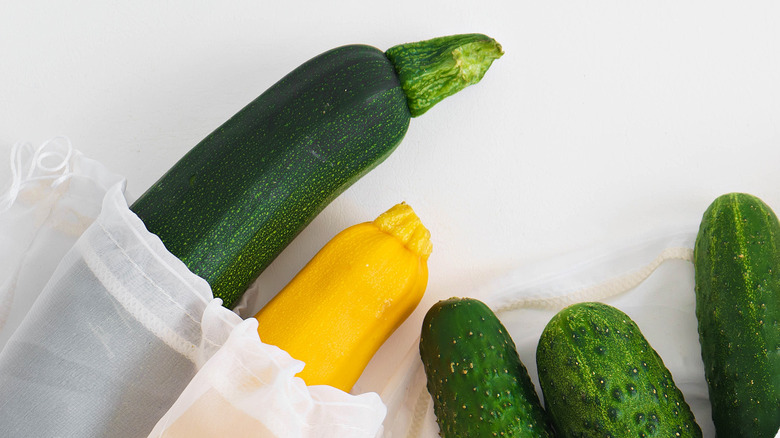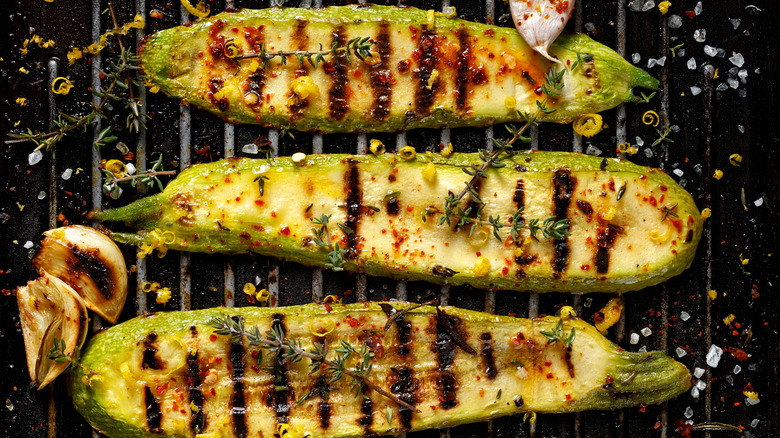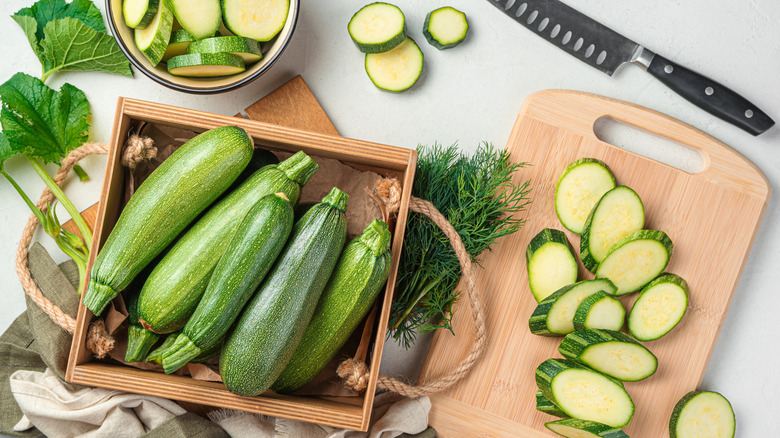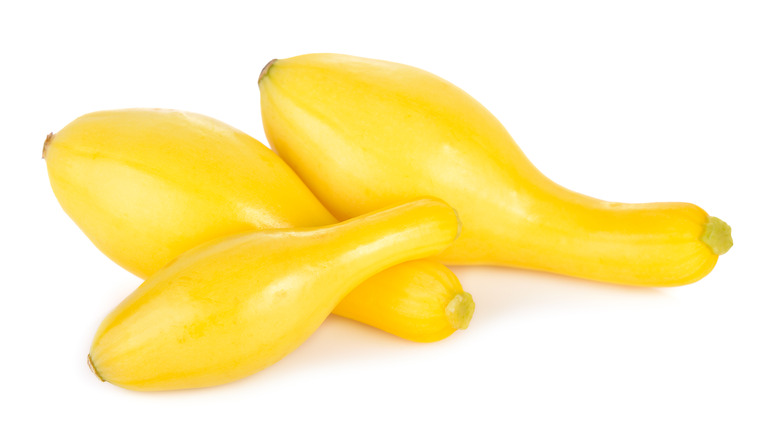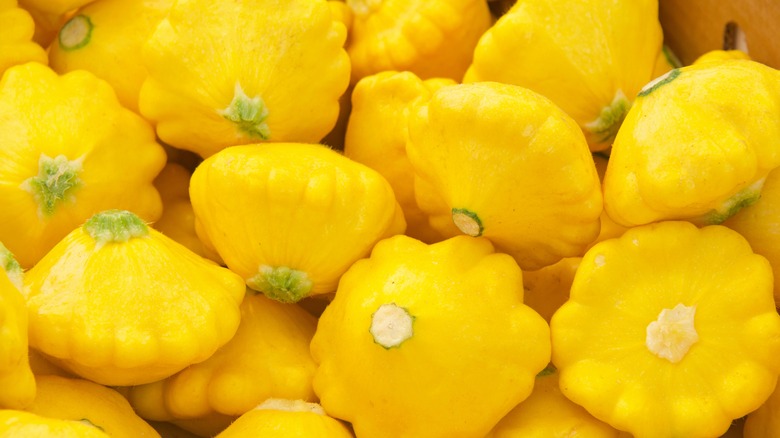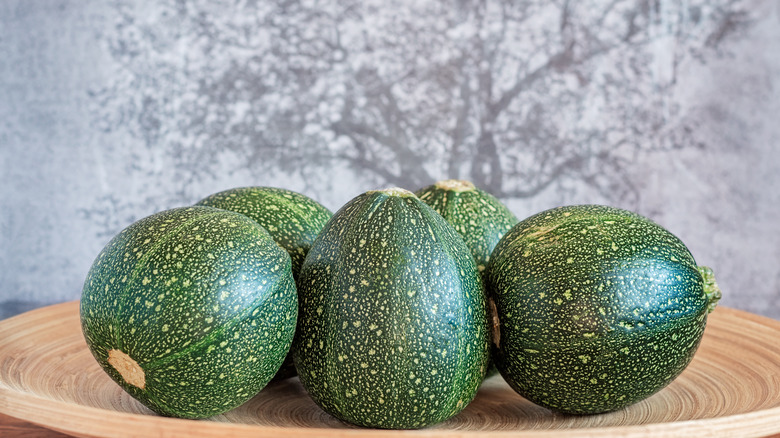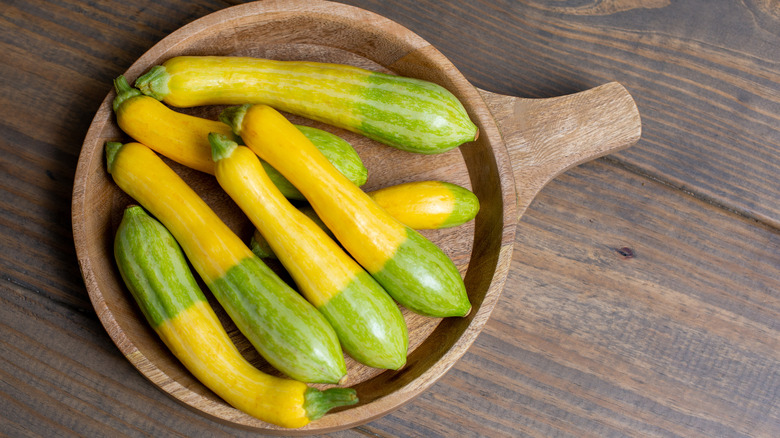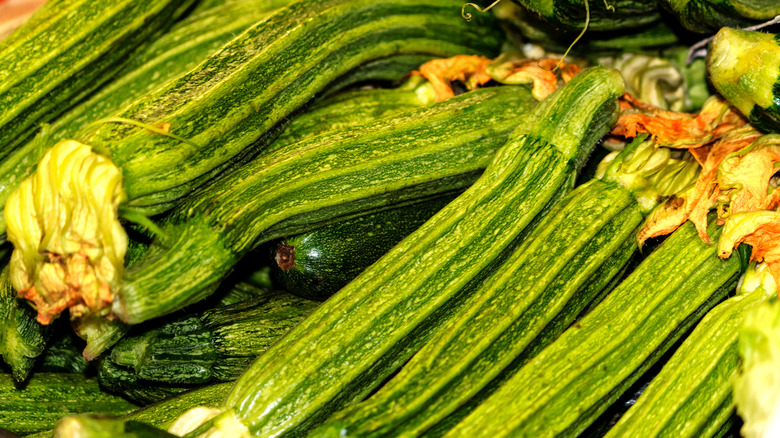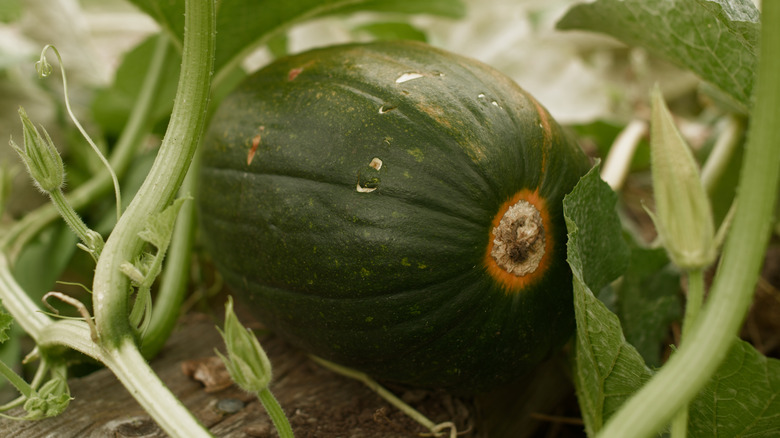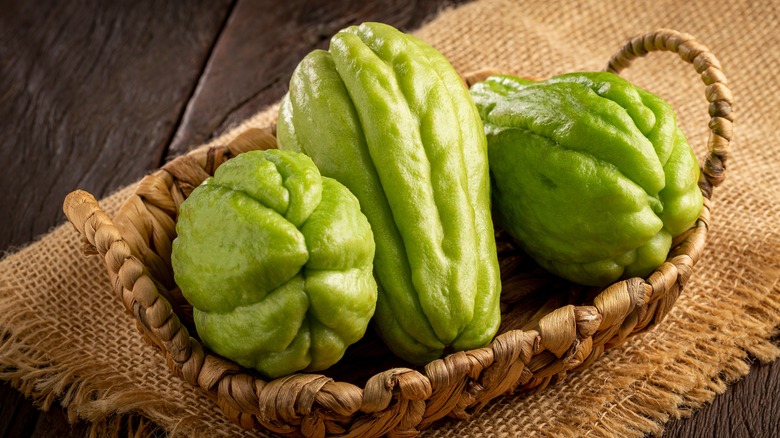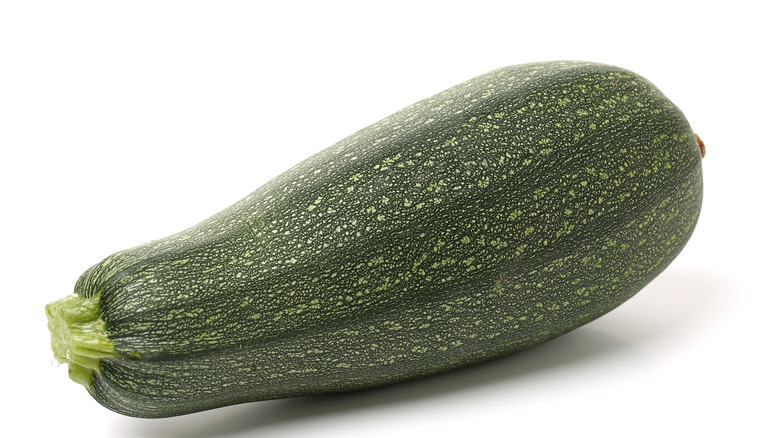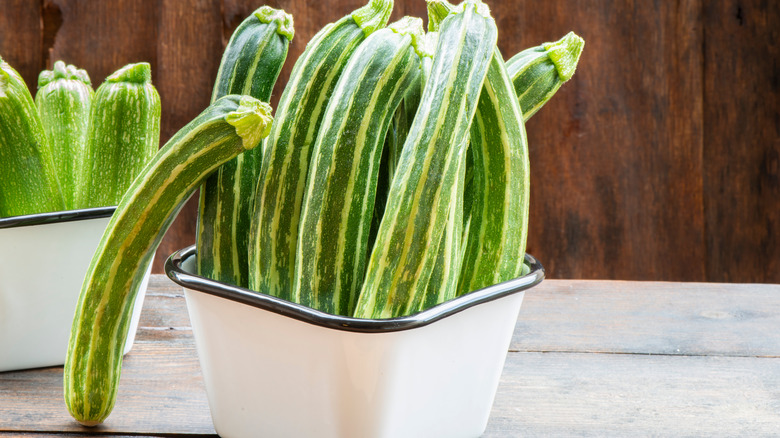The Ultimate Guide To Summer Squash
If you've ever been to a local farmers market, you may have noticed that there are several different types of summer squash. There are numereous squash varieties beyond the more common zucchini and yellow squash that you're more likely to find in the supermarket. Squash may be sold in varying shades of green and yellow, and they may even have some stripes. Their size and shape can even differ quite substantially from what you're used to seeing, with some being long and skinny, some having a crookneck, and others having a spherical shape.
Considering all the different varieties of summer squash, one can easily feel overwhelmed in deciding which variety to use, how choosing the ones that will deliver the best taste and help us decide the different types of summer squash into delicious recipes. There's some key information you should know about many of the types of summer squash you could see on your next trip to the farmers market. Who knows, you could even be inspired to pick up some seeds and grow one of these varieties in your home garden.
What is summer squash?
While many people assume that squash is a vegetable, it is technically a fruit. By definition, squash have a fleshy and tender inside that is covered with a rind. Squash are often separated into two main groups: Summer squash and winter squash. The main difference between these two squash categories lies in how long they grow and stay on the vine.
While summer squash is typically ripe and ready to pick within 60 days (sometimes fewer), winter squash may stay on the vine for up to 120 days (about twice as long as it takes summer squash to be ready). This longer growing time yields a very different finished product. Summer squash has a much thinner and tender rind compared to the hard and thick rind of winter squash: Think about the difference between cutting into a zucchini and an acorn squash or butternut squash. The inside flesh of the squash is also different, with summer squash being more tender and having a lower cooking time than their winter counterparts.
Summer squash (along with winter squash) offer several nutrients that our bodies need. These include iron, magnesium, calcium, potassium, and vitamin B. If you eat the rind (which is plenty soft to do so), you'll also be getting healthy beta-carotene to help your eyes and protect your body against free radicals.
How to choose the best summer squash
Choosing the best summer squash is important. After all, you don't want to get home from the store or farmers market, it's going to be very disappointing to cut into your squash only to realize that it is no good. Beyond staying away from rotten summer squash, you simply want to make sure that the ones you pick will cook up nicely and offer the best flavor. Generally speaking, smaller summer squash will taste better than larger ones. Pick up the squash and handle it.
Look for one that feels a bit heavier given its size, as it is likely to have the best flavor and texture. Most squash will have a few little scratches along their sides; this is to be expected. However, stay away from any with large gouges. Moreover, if the skin is wrinkling or pitted or the squash itself feels overly soft or spongy, you won't want to pick it. These are signs that it is starting to rot and go bad. If you're shopping outside at a farmers market or roadside stand, choose summer squash that is in a shaded area. If squash are left to sit in the sun for too long, they can start to degrade.
How to store summer squash
After you've purchased the summer squash you so carefully selected, you want to make sure that you store it properly so that it doesn't go bad before you get a chance to use it. Fresh squash can keep for up to a week if stored properly. Keep your squash in the plastic produce bags so that it doesn't get too dried out, and leave it in the vegetable crisper in the refrigerator.
If you don't think you'll be able to use all of the squash you purchased before it goes bad, you can also freeze summer squash. Before freezing, the squash will need to be cut and blanched, which is a process in which they are put into a pot of boiling water (no salt added) for just about 1 or 2 minutes. After 2 minutes, move the zucchini to an ice bath and stir everything around to quickly cool it down. The process of blanching helps zucchini (and other vegetables) maintain its texture, color, and flavor when frozen.
After you've finished blanching the zucchini, remove each piece from the ice bath and lay it out on paper towels to remove excess moisture. Once dry, transfer the slices to a baking sheet and put them in the freezer. After a few hours, when the zucchini slices are solid, transfer them to a freezer-safe bag. You can store frozen zucchini for up to 10 months.
How to cook summer squash
There is no one right method of cooking summer squash.In fact, there are many different ways that you can prepare summer squash and use it to enhance the flavor of the meals you are cooking. Summer calls for cookouts and grilling, and you can definitely toss your summer squash onto the grill (or skewer it to cook with a kabob recipe). Before grilling, just brush the squash with a little olive oil and any seasonings you desire.
Roasting summer squash is another popular way to cook it. Slice or chunk the squash, add a little olive oil and a few seasonings, then put it in a hot, 425-degree oven for about 15 minutes. Summer sauce can also be steamed, sautéed, broiled, cooked in the air fryer, and more. Any of these cooking methods can help you make a delicious side dish for a favorite recipe. However, you can also incorporate squash into your main course. For example, try adding it to a cheesy casserole, spiralizing it to make 'noodles,' cutting it in half and stuffing each side with meat and other vegetables, or stir-frying it with some shrimp or scallops.
Zucchini
Zucchini is probably the most well-known type of summer squash. It's the variety you're most likely to see at your grocery store. Zucchini is more or less shaped like a tube, though one end is sometimes a bit wider than the other. It most commonly has a darker green rind with a much paler flesh (mostly white with just the tiniest hint of green). Zucchini is known for its milder taste. When cooked alone, it has a slightly sweet flavor, but when added to other dishes, it does a nice job of pulling in the other flavors you're cooking with.
If you decide to grow your own zucchini, be prepared. It can grow pretty quickly, and you may easily find yourself with more than you'll know what to do with. But, there can be bigger problems than having too much zucchini: Just make friends with your neighbors by sharing the bounty with them. It is also important to avoid letting zucchini grow too big. You've probably seen some that were huge, but they're going to work best in your dishes and have the most tender skin when they're still younger and smaller.
Yellow squash
After zucchini, yellow squash is probably the next most popular variety of summer squash. As its name implies, this variety has yellow skin. The flavor of yellow squash is very similar to that of zucchini. It also does well picking up the flavors of the other ingredients in a dish. For this reason, if a recipe calls for yellow squash or zucchini, you can almost always get away with substituting one for the other.
There are actually several different varieties of yellow squash. They are classified under two main categories: Crooknecks and straightnecks. Crooknecks look precisely like what you'd guess. They have a thin curved neck that resembles a hook. The lower body of the squash is often much rounder and thicker than the neck. A few of the different crookneck yellow squash varieties you might see include Pic-N-Pic, Early Summer, and Supersett. Straightneck yellow squash don't have hook-shaped necks. They have straighter necks, so they are also less fragile and less likely to break when being transported.
Pattypan squash
Pattypan squash is an interesting-looking variety that you might want to try if you ever run across it at a farmers market. You may also see this type labeled scallop squash. The uniquely-shaped squash earned both of these names because of how much it looks like a scalloped pie pan. Sometimes, these summer squash are even called flying saucer squash because of how their appearance can also conjure up thoughts of UFOs. Pattypans are available in a range of different colors; many are shades of yellow or green, and a few may even be white.
If you're looking for the best-tasting pattypans, choose ones with a smaller size. These will be younger and are more likely to have the best taste and texture. If pattypans are allowed to grow too large, not only does their skin become too thick, but their seeds can also get too hard and tough. Moreover, the taste is off, more closely resembling that of a potato than other types of squash.
Eight ball zucchini
Eight ball zucchini are another uniquely-shaped variety that you will want to try. Like other types of summer squash, you can find both smaller and larger eight balls. However, unlike many other types of squash with a more cylindrical shape, eight ball squash are shaped like an oval or ball (hence the name). They are typically anywhere between 5 and 12 centimeters in length with slightly tapered ends, one with the thick stem that you'll find on different varieties of squash. Eight ball zucchini have a dark green rind that matches the color of regular zucchini. Their inner flesh is mostly white, with pale yellow and green undertones.
The flavor of eight ball zucchini is similar to that of other types of squash, with some unique enhancements. It has a mildly nutty taste that is just a bit sweet. So, basically, the perfect taste to pair with all of your summer recipes. You can slice them and cook them as you would zucchini or other types of squash, but because of their rounder shape, many people like to stuff them with meat, cheese, rice, and other ingredients.
Zephyr squash
Zephyr squash have a very unique look with their bi-colored skin. The bottom half of the squash is light green, while the top half is yellow. There are also faint white stripes along the skin, which will be easier to see when the squash is fully-grown. Zephyr is typically a straightneck squash with a cylindrical shape. The squash was actually the result of breeding by Johnny's Selected Seeds. During the breeding process, three different types of squash were used: Delicata, yellow crookneck, and acorn. Because of its ancestry, you may find some zephyr squash with a crookneck.
As with several other types of squash, zephyr will taste best if they are picked before they get too big. The larger squash will have tougher skin that you'll probably want to peel off before cooking. Aim to pick zephyr squash when they are between 4 and 7 inches long. Zephyr squash has a sweet, mild flavor with hints of nuttiness.
Costata Romanesco
If you've never heard of costata Romanesco squash, then you've been missing out. It is an Italian heirloom variety that is sought out by many gardeners, both for its amazing flavor and its interesting appearance. While costata Romanesco has a cylindrical shape, similar to that of zucchini, there is one defining feature that makes it easily identifiable. While zucchini and many other summer squash varieties have smooth skin, the skin of costata Romanesco is ribbed, which is likely the reason it is referred to as Italian ribbed squash.
Costata Romanesco, because of its ribbed sides, even has a unique shape once sliced. Each slice looks like a little star. It can certainly add a fun twist to all of your favorite recipes. While it is possible for costata Romanescos to grow to be as long as 15 inches, they are best when picked at a length closer to 6 inches.
Tatume
Tatume squash, also known as tatuma or calabacita, is another interesting variety to try. The squash, which is native to Mexico, grows well in hot temperatures. Tatume squash may come in different shapes. Some look similar to zucchini, while others have a ball-like shape. Their skin is green, which can make the round varieties look like mini watermelons. However, you shouldn't try to grow your tatume squash to anywhere near the size of a real watermelon. If they get larger than baseball size, the skin can become too tough to really enjoy.
The inner flesh of a tatume squash is firmer than that of many other squash varieties. However, despite its firmer texture, it offers a much sweeter flavor that you may not expect. If you're thinking about planting tatume squash in your garden, only do so if you have plenty of space for the vines to grow, as they have been known to grow to be up to 12 feet long.
Chayote squash
At first glance, you might think chayote squash is a pear. The lighter green shape has a wider base that tapers to a thinner top, just like a pear. However, it is indeed a type of squash. The skin on a chayote squash is lumpier and bumpier than that of other types of squash. Its inner flesh is also firmer and crunchier than many other varieties. However, like zucchini, the inner flesh is known to absorb the flavors of the other ingredients mixed with it, meaning that you can add chayote squash to so many different recipes.
When chayote is ripe, it should feel pretty firm. The skin should be green, not too dark, but also not too light, and free of soft or brown spots. Some people even enjoy munching on raw chayote squash. You can add it to a salad or dip it in some hummus or onion dip. If you don't want to eat it raw, then use it much like you would zucchini or yellow squash to roast, sauté, or make soups.
Caserta
Caserta is one variety of zucchini, which explains why the two types of squash look rather similar. Like zucchini, it has darker green skin. However, unlike zucchini, the skin is striped, with sections of even darker green. The shape of a caserta squash is also a little more tapered and less perfectly cylindrical than many other types of zucchini.
As with several other types of squash, it is best to pick caserta squash before they get too large. Aim to harvest when the length is between 4 and 8 inches long. You could luck out, though, if you miss picking one. Some have been known to stay tender and delicious after reaching lengths up to 16 inches. The stripes on a larger caserta will be even more pronounced than those on a less mature one. Caserta squash, which were bred at the University of Connecticut, were the All-America Selections winner in 1949.
Green tiger
Green tiger is another striped zucchini variety. The squash is cylindrical in shape, with dark green and light green stripes. The contrast between the lighter and darker colors is quite striking. Most green tiger squash are harvested when they are between 6 and 8 inches long. However, this is a good variety to pick early (when they're around 3 to 4 inches long) if you're looking for cute mini squash.
People who have tried green tiger squash are usually fans of its flavor. It has an overall mild flavor with a hint of nuttiness. The flavor makes this squash an ideal choice for a range of dishes, from sautéed squash to cheese squash casseroles and everything in between. One benefit of green tiger squash for home gardeners is that the plants are very resistant to different diseases and mildew, including the zucchini yellow mosaic virus, watermelon mosaic virus, and powdery mildew.
